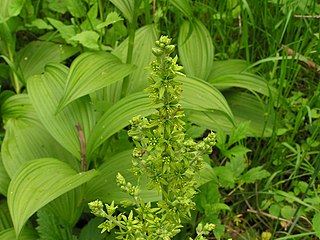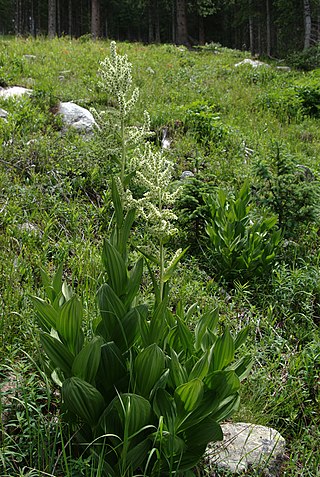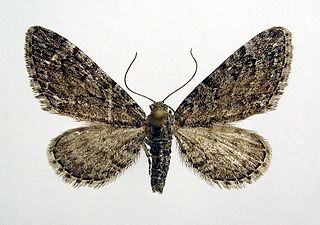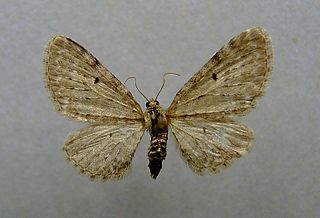
Melanthieae is a tribe of flowering plants within the family Melanthiaceae. Molecular phylogenetic studies in the 21st century have resulted in a large-scale reassignment of many of its species to different genera; in particular the genus Zigadenus (deathcamases) has been restricted to a single species, Zigadenus glaberrimus. Plants contain alkaloids, making them unpalatable to grazing animals; many are very poisonous to both animals and humans.

Eupithecia is the largest genus of moths of the family Geometridae, and the namesake and type genus of tribe Eupitheciini. Species in the genus are, like those of other genera in the tribe, commonly known as pugs. The genus is highly speciose, with over 1400 species, and members of the genus are present in most of the world with exception of Australasia. Roughly a quarter of described Eupithecia species occur in the Neotropical realm, where they have an especially high species diversity in the montane rain forests of the Andes. The genus includes a few agricultural pest species, such as the currant pug moth, Eupithecia assimilata, which is a pest on hops, and the cloaked pug moth, Eupithecia abietaria, which is a cone pest in spruce seed orchards.

The grey pug is a moth of the family Geometridae. It is found throughout the Palearctic region. It is also found in North America. Since it does not place any special demands on climatic conditions, special caterpillar food plants, geological subsoil or the like it is a typical species of almost any Hochstaudenflur, where it occurs in the herb layer, in bushes and even on deciduous trees. It can be found on forest edges and hedgerows, on heath, in rocky places and wetlands, parks and gardens, as well as in villages and town centres.

The tawny speckled pug is a moth of the family Geometridae.

Veratrum viride, known as Indian poke, corn-lily, Indian hellebore, false hellebore, green false hellebore, or giant false-helleborine, is a species of Veratrum native to eastern and western North America. It is extremely toxic, and is considered a pest plant by farmers with livestock. The species has acquired a large number of other common names within its native range, including American false hellebore, American white hellebore, bear corn, big hellebore, corn lily, devil's bite, duck retten, itchweed, poor Annie, blue hellebore and tickleweed.
White hellebore or white false hellebore is a common name for several plants and may refer to:

Veratrum is a genus of flowering plants in the family Melanthiaceae. It occurs in damp habitats across much of temperate and subarctic Europe, Asia, and North America.

Veratrum album, the false helleborine, white hellebore, European white hellebore, or white veratrum is a poisonous plant in the family Melanthiaceae. It is native to Europe and parts of western Asia.

Veratrum californicum is an extremely poisonous plant native to western North America, including the Sierra Nevada and Rocky Mountains, as far north as Washington and as far south as Durango; depending on latitude, it grows from near sea level to as high as 11,000 feet. It grows 1 to 2 meters tall, with an erect, unbranched, heavily leafy stem resembling a cornstalk. It prefers quite moist soil, and can cover large areas in dense stands near streams or in wet meadows. Many inch-wide flowers cluster along the often-branched top of the stout stem; they have 6 white tepals, a green center, 6 stamens, and a 3-branched pistil. The buds are tight green spheres. The heavily veined, bright green leaves can be more than a foot long.

Veratrum insolitum is a species of false hellebore, a type of plant closely related to the lily. Its common name is Siskiyou false hellebore. It is native to the northwestern United States: Washington, western Oregon, and northwestern California as far south as Trinity County.

Freyer's pug is a moth of the family Geometridae. The species can be found in Europe, east to the Urals, the Russian Far East, Kazakhstan and China. It is also found in North America.

Eupithecia tripunctaria, the white-spotted pug, is a moth of the family Geometridae. The species can be found from Europe to Korea and Japan and in North America.

Melanthium is a genus of herbaceous perennial plants native to North America. They are closely related to Veratrum, and in fact are included in that genus by some authors. The distinction between Melanthium and Veratrum is based on various morphological traits, but it is not yet clear where the line is best drawn.

Eupithecia satyrata, the satyr pug, is a species of moth of the family Geometridae. It was described by Jacob Hübner in 1813. It is found from Ireland, through northern and central Europe east to all of Russia and central Asia and western Siberia to Tibet. It is also present in North Africa and North America.

Eupithecia gelidata is a moth of the family Geometridae. It is known from northern North America, Greenland, northern Russia, Scandinavia and northern central Europe.

Veratrum hybridum is a species of flowering plant in the Melanthiaceae known by the common names slender bunchflower and crisped bunchflower. Many publications use the synonyms Melanthium latifolium and Veratrum latifolium, but the "hybridum" epithet is 9 years older than the "latifolium," so Veratrum hybridum is now the accepted name.

Eupithecia veratraria is a moth of the family Geometridae first described by Gottlieb August Wilhelm Herrich-Schäffer in 1848. It is found from the mountainous areas of Europe and Asia up to Japan.
Eupithecia carpophagata is a moth in the family Geometridae. It is found in the mountains of Europe, including the eastern Pyrenees, the central and southern part of the Alps, the Massif Central, the central Apennines and the Balkan Peninsula.
Eupithecia undata is a moth in the family Geometridae first described by Christian Friedrich Freyer in 1840. The North American Moth Photographers Group lists it as a synonym of Eupithecia lafontaineata. It is found in the Pyrenees, Alps, the Massif Central, the Tatra mountains, on the Balkan Peninsula and in Romania. It is also found in North America, where it has been recorded from Wyoming, Montana, Idaho, Colorado, Nevada and Oregon.















